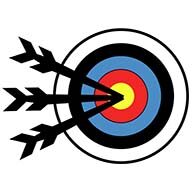When I just started with archery, my coach told me that the choice between a finger sling and arm sling is purely based on personal preference. If we look at professional archers we see, however, that 95% of recurve archers use a finger sling, while the opposite is true for compound archers. Therefore there seems to be an inherent difference between the two options which makes it more suited for certain shooting styles. In this article, I will discuss the difference between finger and wrist slings, and how you should make your choice.
To give you a quick answer to the question in the title: Finger slings are not inherently better than wrist slings. Finger slings tend to be more favored by recurve archers because this enables you to do the free fall swing. This technique however is not a necessity to shoot accurately. In this article, I will discuss this in more detail. I will also discuss some pros and cons of both options; how to configure them and I will provide you with an alternative.
The differences between finger and wrist slings
Of course, the most obvious difference between the finger and wrist sling is how the bow is caught if it drops. When you use a finger sling, the weight of the bow will drop on your index finger and thumb. With a wrist sling, the weight of the bow will rest on the wrist. For most starting archers a wrist sling is therefore recommended because it tends to be more comfortable.
Why most recurve archers prefer finger slings
There is, however, another more subtle difference between the two options that are not often discussed. If the bow drops it’s way easier to control the drop with a finger sling than with an arm sling. When the bow drops, it will tip over until it’s held back by either the finger or wrist sling. This creates the iconic swing that you often see in professional recurve archery, which is called the free-fall swing.
Wrist slings are most often mounted on the stabilizer or just below it. Therefore the bow will be very top-heavy and swing very far. Because there is no stopping point, the bow can be rather erratic when you fully drop the bow. Therefore archers that use a wrist sling don’t swing the bow but catch it after the arrow is shot.
The finger sling, however, catches the bow higher on the riser, near the grip. This makes the point of balance more in the center of the bow. Therefore the bow will be less top-heavy and will swing less far. Additionally, because the swinging point is near your hand, the bow will catch in the palm of your hand and come to a stop. Therefore dropping the bow will not cause erratic behavior. Therefore it is the only real option for archers that want to use the swing technique.
It can, however, be more difficult to catch the bow if you don’t want to use the swing technique. The sling tends to restrict your finger movement; therefore most archers that don’t want to use the swing technique prefer a wrist sling. This can be very hard to describe therefore, I would recommend watching the video below. It is way easier to visualize.

Why most compound archers prefer wrist slings
Compound archers don’t use the free fall swing technique. This technique is not a benefit for compound archers because most compound archers use drop-away arrow rests, therefore jerking the bow hand is less of an issue. Compound bows tend to be heavier; therefore it can be very in comfortable to drop the bow in a finger sling. Therefore most compound archers prefer wrist slings because they are easier to use and tend to be more comfortable.
Pros and cons
See the figure below for a quick summary of the most important pros and cons of both slings.
| Finger sling | Wrist sling | |
| Pros | Catches the bow early in the drop | Easier to get used to |
| Allows for the free fall swing technique | Tends to be more comfortable | |
| The drop of the bow is easy to control | Doesn’t restrict finger movement | |
| Cons | Can become uncomfortable | You can’t use the free fall swing technique |
| Can be really hard to get used to | If the bow falls it tends to react erratically | |
| Restricts finger movement | If the bow falls it will pull hard on your wrist |
Is the free fall swing technique essential?
The free fall swing technique is used to make sure that the archer doesn’t jerk the riser. This often happens when you have a tight grip on the riser. When all the force of the bow is released, your muscles will lag behind, and therefore might jerk the riser. The most common mistake is to jerk the riser upwards resulting in inaccurate shots. Therefore archers don’t grip the riser tightly but rather hold it loosely.
This can feel really strange when you are not used to it. We are used to holding things firmly so we don’t drop them; it’s a very natural thing to do. If you don’t grip the bow it will fall after the shot, this is essentially the free-fall swing technique. By letting the bow fall, archers essentially prevent jerking the bow at the last second. You can also check whether you were consistent with your grip by analyzing the swing.
This is, however, not the only way to make sure that you don’t manipulate the bow. Another technique a lot of archers use is to grab the bow in mid-air directly when the arrow left the bow. You still don’t grip the bow, but instead of letting the bow completely fall, you catch it. This might seem difficult, but this is actually a very natural reaction. With the free swing technique, you really have to force yourself to let it fall.
Therefore the free fall swing technique is not an essential technique. An archer on a forum named Archerytalk even said: ‘’the free fall swing is just style points’’. I don’t think that this is the case, but the entire swing is not necessary, since the arrow has already left the bow. It is a good way, however, to be absolutely clear that you didn’t grip the riser. And of course, it makes you look cool, which is always a plus :).
Do I really need a wrist or finger sling?
You might wonder if you even need a wrist or finger sling because dropping the bow is really rare. I understand this point, but if your bow drops you will probably damage many parts. Therefore you can prevent a lot of frustration by using either a wrist or finger sling. If you only shoot on the field, a wrist or finger sling might not be necessary. If you drop the bow, it will most likely not be severely damaged. But even on soft grass, some fragile parts may break. Therefore I would highly recommend using a wrist or finger sling.
Recommended slings
There are a lot of wrist, finger, and hybrid slings available. Below I have listed my favorite options.
Finger sling
The most important aspect of a finger sling is comfort. You want a finger sling that is soft and thick. Thin and sharp finger slings will get uncomfortable. Therefore, I recommend this finger sling from Avalon. The sling is made from elastic cloth which makes for a secure and comfortable fit.
Wrist sling
Some wrist slings are attached to the riser with a buckle system, but I prefer a system where you screw it on the stabilizer port. This makes for a more secure fit and prevents scratches from the buckle as I explain in this article.
Therefore, I recommend this 550 Paracord wrist sling from Legend Archery. This sling is made from paracord, which makes it exceptionally durable, and it also looks nice. In a survival situation, you can even use the paracord to start a fire or make a shelter. Every hunter or 3D archer should have one of these paracord wrist slings!

Hybrid sling
Since hybrid slings are only used by a very small portion of the archery community it can be quite difficult to find one online. Luckily I this Shibuya Archery hybrid sling, in case you want to give it a try. I don’t shoot with a hybrid sling, so I can’t give more information about it. But in general, I think having a thick soft rope would be ideal since the weight will rest mostly on your fingers.
DIY slings
Especially the finger sling and the hybrid sling are very simple devices. So, if you want, you can always make them yourself. With some extra effort, you can also make a wrist sling out of some paracord. If you have to buy the materials, it will probably cost more, but it can be a fun project! Below I discuss in a bit more detail, how you can make your sling.
How to make a finger sling
You can make your finger sling from an old shoelace or paracord. It should be a bit stretchy to work. I have added a video below that explains how to make a simple finger sling from a shoelace.
The most important thing to consider is the length between the two finger loops. Although some archers disagree I don’t think there is a predetermined length. It depends not only on your hand but also on the grip and riser. My finger sling has a 3 ½ inch cord (9 cm) between the finger loops, but I believe I have quite a fat grip and long fingers, so you might need a shorter finger sling. The best way is to just experiment with different lengths and find out what works for you.
How to make a wrist sling
Although wrist slings are a bit more complicated than finger slings, you can still easily make it yourself. You can easily braid a wrist sling from any piece of rope, but especially paracord tends to work great. See the video below on how to make a wrist sling from paracord.
The wrist sling should never be tight around your wrist when you hold the bow. It should be loosely resting on your wrist when firing. The wrist sling should only be under tension when you accidentally drop the bow. Therefore it is better to make the wrist sling a bit looser than a bit too tight. Just be sure not to make it too loose so that it may slip over your hand when you drop the bow.
How to make a hybrid sling
Making a hybrid sling is relatively straightforward, simply follow the guide below:
Tim van Rooijen
For as long as I can remember, I have always been fascinated by archery. First due to its historic significance but later because I like being outdoors. With this blog, I share my knowledge about Archery and how you can improve your shot. More about author…



